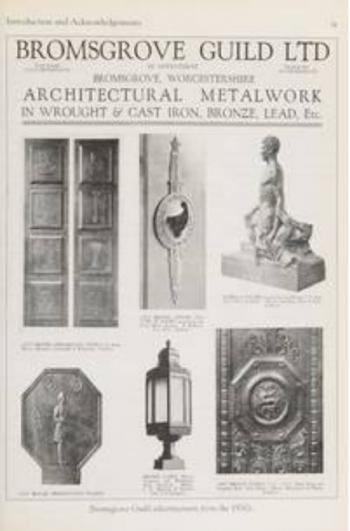Bromsgrove Guild
Bromsgrove Guild of Applied Arts was founded in 1898 by artist craftsman Walter Henry Gilbert. It originated from the nearby Bromsgrove School of Art where Gilbert had recently been appointed Headmaster. Guild members were all professional craftspeople and trained artisans independent from one another although they did cooperate when needed. Within 12 months the Guild had built its own premises and was soon producing metalwork, glass, mosaics, furniture and carved wood, jewellery, enamels and decorative plasterwork. By the early years of the 20th century, the Guild had opened workshops in London, Glasgow, Edinburgh and other major centres across Britain. Members often exhibited their works at the Arts and Crafts Exhibition Society annual shows in 1899, 1903, 1906, 1910, and 1912, which were normally based in London. In 1900, the Guild participated in the Exposition Universelle in Paris where they were winners in various categories. The Guild was also represented at Exposition d'Arts Décoratifs de Grand-Bretagne et d'Irlande, the last great exhibition of the British and Irish Arts & Crafts movement, held at the Palais du Louvre in Paris in 1914. Members received prestigious commissions including supplying the metal gates for Buckingham Palace and the Queen Victoria Memorial in front of the Palace. The Guild lasted until its dissolution in 1966 although sadly its final years saw the workforce and skills vastly reduced.
The pre-World War I years are seen as the heydey of the Guild. It had acquired a Royal Warrant and had nearly 150 employees working throughout Britain and even had branches in Canada and the USA. However, in 1918 Walter Gilbert was induced to move to a rival company, H.H. Martin of Cheltenham, and many of the Guild's leading craftsmen followed him. Despite this loss, the Guild continued to survive for more than another five decades. This may largely be the result of commissions they received for war memorials during the inter-war years, and because of the need for craftsmen to repair bomb damage following World War II. The Guild eventually succumbed to financial difficulties and closed in 1966.
Among the designers and craftspeople who worked for the Guild during its history were Sidney Harold Meteyard, Celestino Pancheri, Henry George Rushbury, Albert Edward Lemmon, Benjamin Creswick, Bernard Sleigh, Joseph (Josef) Hodel, Georgie Evelyn Cave Gaskin, Louis Weingartner, Arthur Joseph Gaskin, Amy Walford, Archibald John Davies, Leopold Weisz, Joseph Sanders, William Cowper, Ernest Cowper, (1879-1959) Frederick Osborne, Charles Bonnet, Richard Tapp, George Percy Bankart, Henry Albert Payne, Michael Hewan Crichton, Herbert Whewell, Mary Jane Newill, Charles Arthur Llewelyn Roberts and Benjamin Warren.
Get Unlimited Access from just £5


